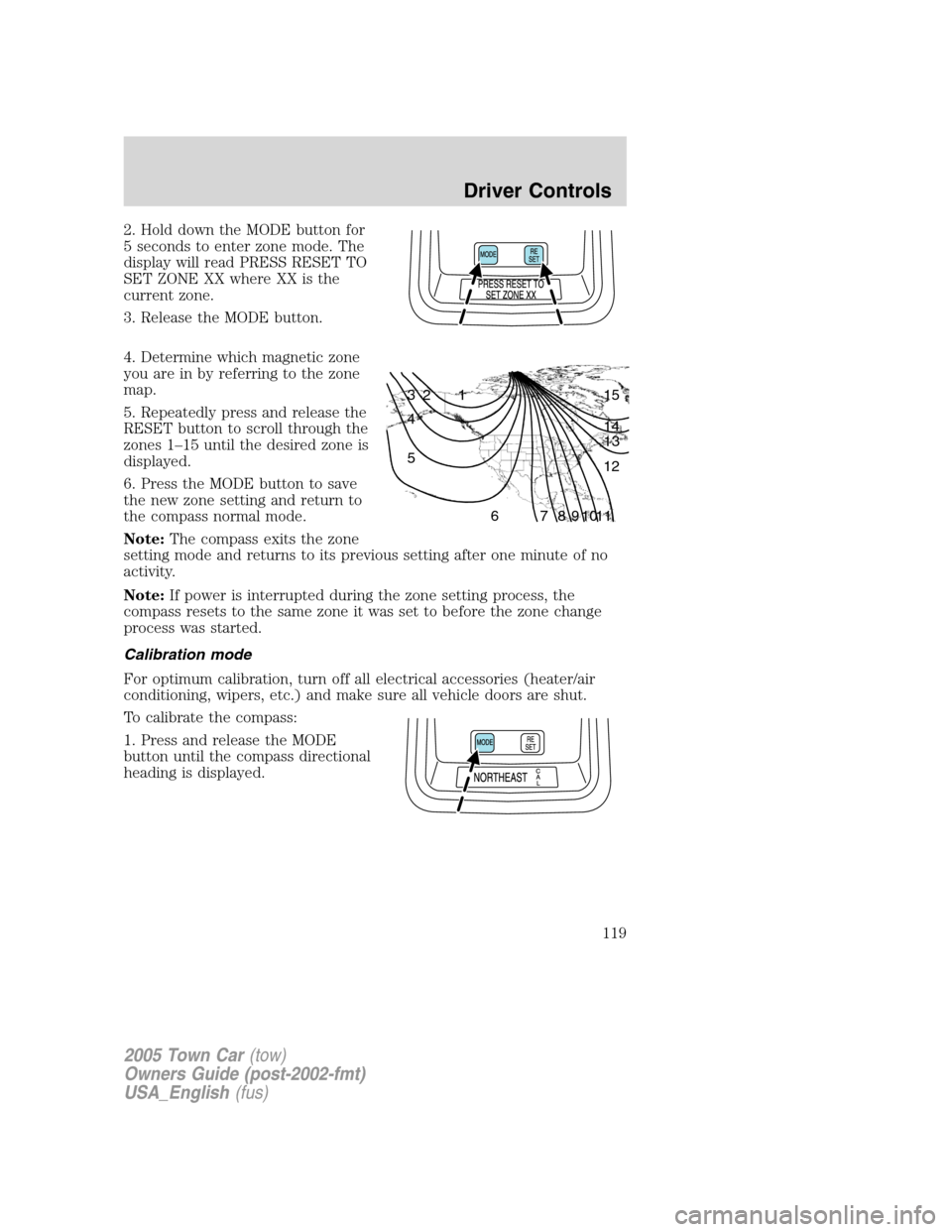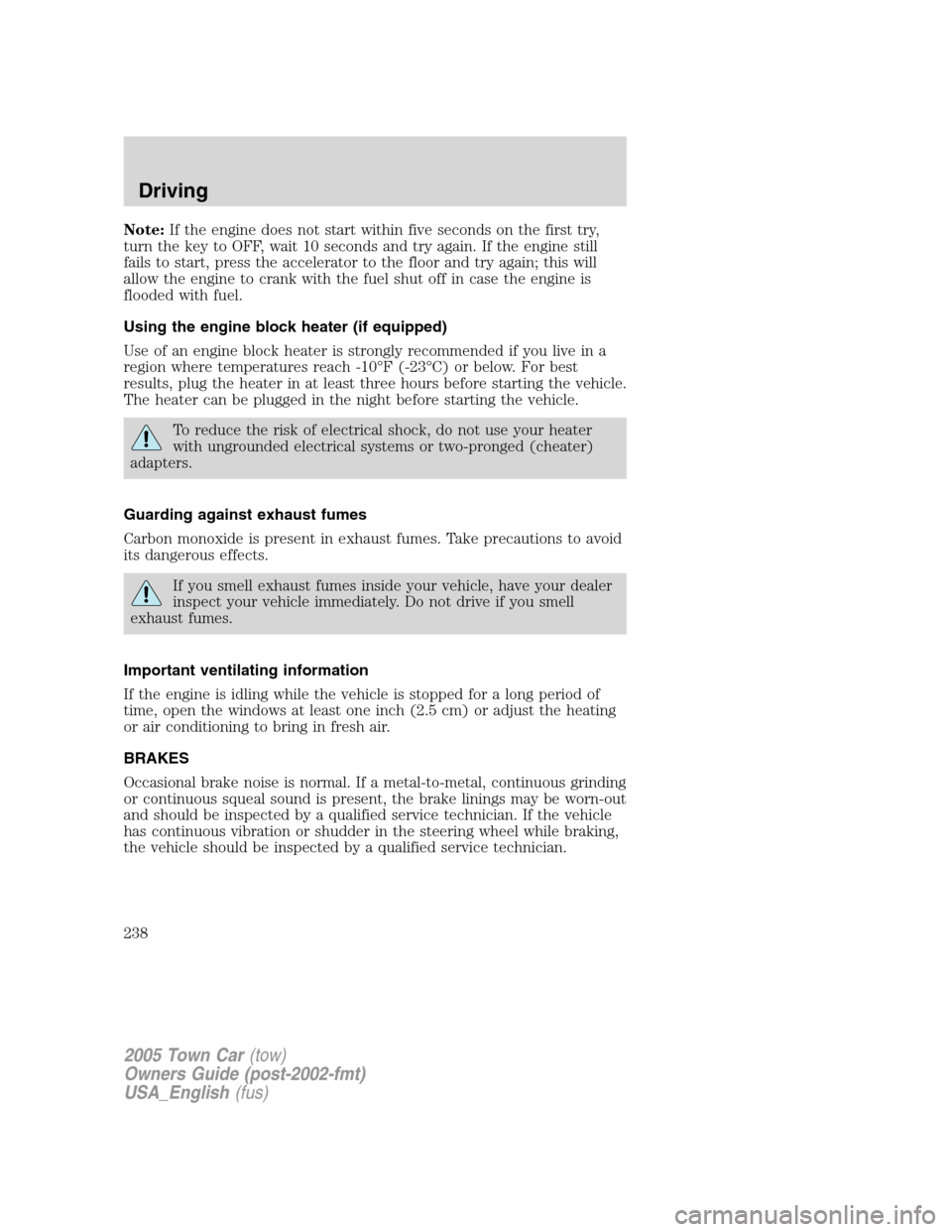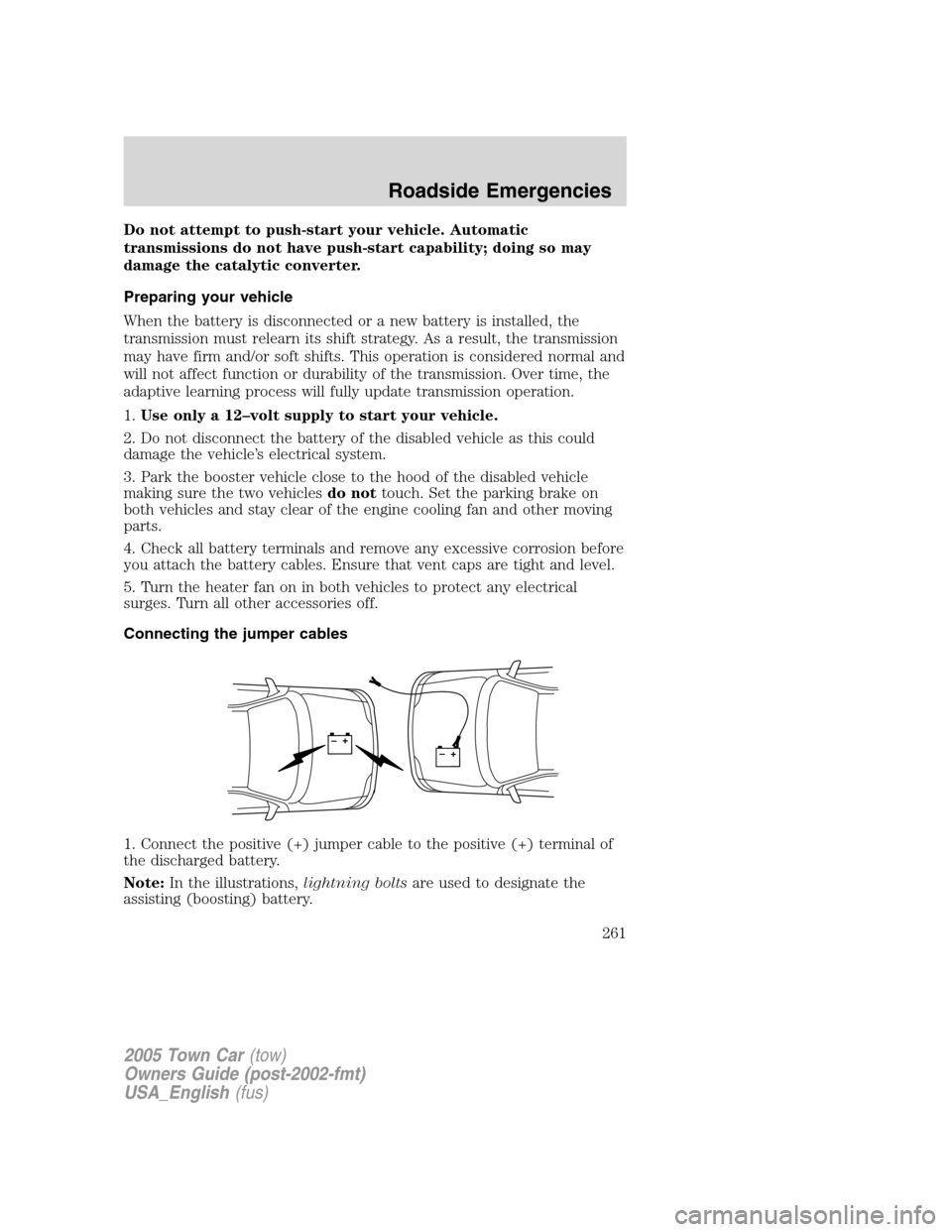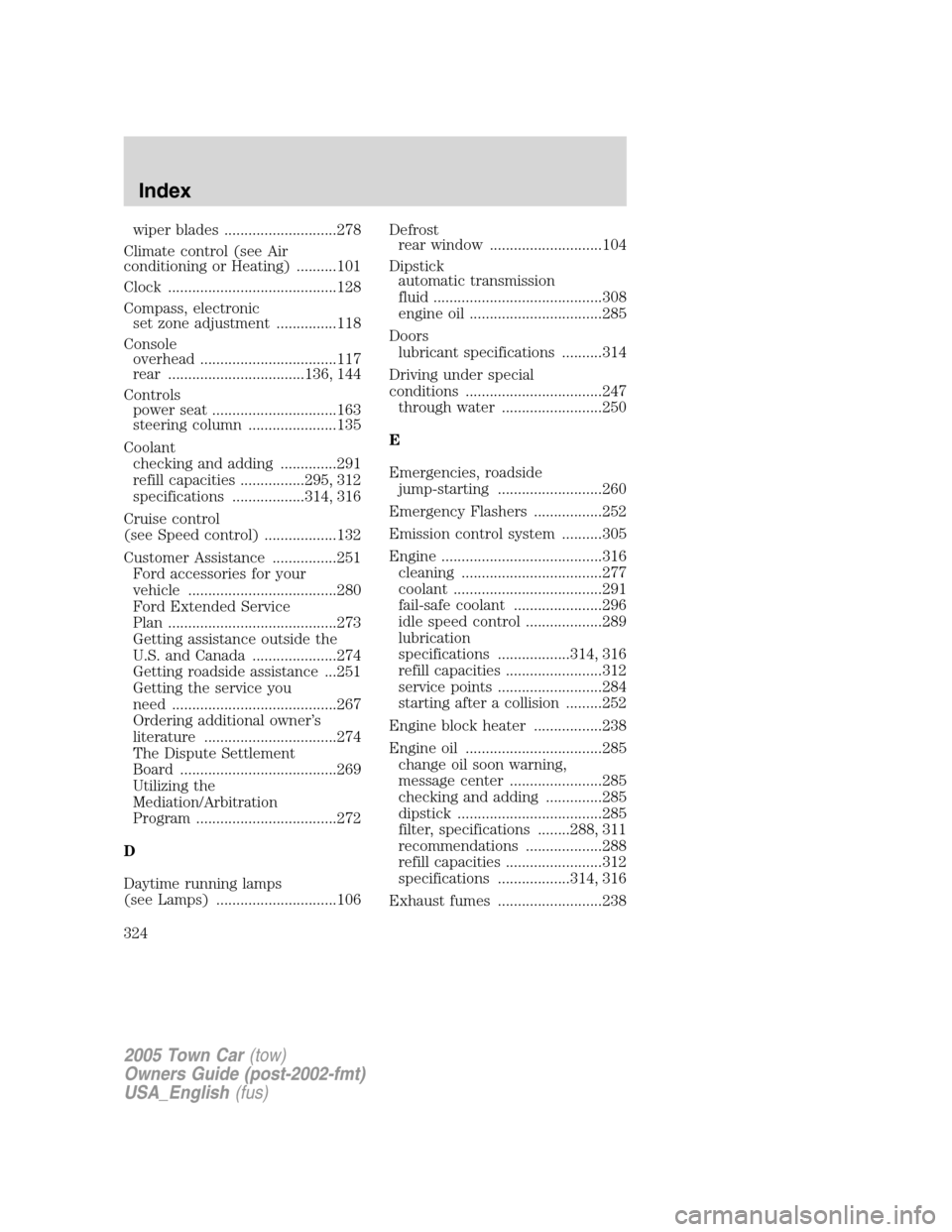2005 LINCOLN TOWN CAR heater
[x] Cancel search: heaterPage 119 of 328

2. Hold down the MODE button for
5 seconds to enter zone mode. The
display will read PRESS RESET TO
SET ZONE XX where XX is the
current zone.
3. Release the MODE button.
4. Determine which magnetic zone
you are in by referring to the zone
map.
5. Repeatedly press and release the
RESET button to scroll through the
zones 1–15 until the desired zone is
displayed.
6. Press the MODE button to save
the new zone setting and return to
the compass normal mode.
Note:The compass exits the zone
setting mode and returns to its previous setting after one minute of no
activity.
Note:If power is interrupted during the zone setting process, the
compass resets to the same zone it was set to before the zone change
process was started.
Calibration mode
For optimum calibration, turn off all electrical accessories (heater/air
conditioning, wipers, etc.) and make sure all vehicle doors are shut.
To calibrate the compass:
1. Press and release the MODE
button until the compass directional
heading is displayed.
1 2 3
4
5
6 7 8 9 101112 13 14 15
2005 Town Car(tow)
Owners Guide (post-2002-fmt)
USA_English(fus)
Driver Controls
119
Page 238 of 328

Note:If the engine does not start within five seconds on the first try,
turn the key to OFF, wait 10 seconds and try again. If the engine still
fails to start, press the accelerator to the floor and try again; this will
allow the engine to crank with the fuel shut off in case the engine is
flooded with fuel.
Using the engine block heater (if equipped)
Use of an engine block heater is strongly recommended if you live in a
region where temperatures reach -10°F (-23°C) or below. For best
results, plug the heater in at least three hours before starting the vehicle.
The heater can be plugged in the night before starting the vehicle.
To reduce the risk of electrical shock, do not use your heater
with ungrounded electrical systems or two-pronged (cheater)
adapters.
Guarding against exhaust fumes
Carbon monoxide is present in exhaust fumes. Take precautions to avoid
its dangerous effects.
If you smell exhaust fumes inside your vehicle, have your dealer
inspect your vehicle immediately. Do not drive if you smell
exhaust fumes.
Important ventilating information
If the engine is idling while the vehicle is stopped for a long period of
time, open the windows at least one inch (2.5 cm) or adjust the heating
or air conditioning to bring in fresh air.
BRAKES
Occasional brake noise is normal. If a metal-to-metal, continuous grinding
or continuous squeal sound is present, the brake linings may be worn-out
and should be inspected by a qualified service technician. If the vehicle
has continuous vibration or shudder in the steering wheel while braking,
the vehicle should be inspected by a qualified service technician.
2005 Town Car(tow)
Owners Guide (post-2002-fmt)
USA_English(fus)
Driving
238
Page 257 of 328

Fuse/Relay
LocationFuse Amp
RatingPassenger Compartment Fuse
Panel Description
24 15A LCM (High beams), Multi-function
switch (Flash-to-pass)
25 10A Brake-Transmission Shift Interlock
(BTSI), Stop switch signal feed,
Speed control deactivation switch
26 15A LCM (Park lamps, cornering
lamps)
27 10A DATC module
28 10A Center High-Mounted Stop Lamp
(CHMSL)
29 15A Turn signals
30 15A Stop lamps
31 10A A/C cycle switch, Heated seats
module
32 10A Mirror heaters
33 15A Audio, Navigation
K101 — Rear defroster relay
Power distribution box
The power distribution box is located in the engine compartment. The
power distribution box contains high-current fuses that protect your
vehicle’s main electrical systems from overloads.
Always disconnect the battery before servicing high current
fuses.
To reduce risk of electrical shock, always replace the cover to
the Power Distribution Box before reconnecting the battery or
refilling fluid reservoirs.
If the battery has been disconnected and reconnected, refer to the
Batterysection of theMaintenance and Specificationschapter.
2005 Town Car(tow)
Owners Guide (post-2002-fmt)
USA_English(fus)
Roadside Emergencies
257
Page 261 of 328

Do not attempt to push-start your vehicle. Automatic
transmissions do not have push-start capability; doing so may
damage the catalytic converter.
Preparing your vehicle
When the battery is disconnected or a new battery is installed, the
transmission must relearn its shift strategy. As a result, the transmission
may have firm and/or soft shifts. This operation is considered normal and
will not affect function or durability of the transmission. Over time, the
adaptive learning process will fully update transmission operation.
1.Use only a 12–volt supply to start your vehicle.
2. Do not disconnect the battery of the disabled vehicle as this could
damage the vehicle’s electrical system.
3. Park the booster vehicle close to the hood of the disabled vehicle
making sure the two vehiclesdo nottouch. Set the parking brake on
both vehicles and stay clear of the engine cooling fan and other moving
parts.
4. Check all battery terminals and remove any excessive corrosion before
you attach the battery cables. Ensure that vent caps are tight and level.
5. Turn the heater fan on in both vehicles to protect any electrical
surges. Turn all other accessories off.
Connecting the jumper cables
1. Connect the positive (+) jumper cable to the positive (+) terminal of
the discharged battery.
Note:In the illustrations,lightning boltsare used to designate the
assisting (boosting) battery.
+–+–
2005 Town Car(tow)
Owners Guide (post-2002-fmt)
USA_English(fus)
Roadside Emergencies
261
Page 324 of 328

wiper blades ............................278
Climate control (see Air
conditioning or Heating) ..........101
Clock ..........................................128
Compass, electronic
set zone adjustment ...............118
Console
overhead ..................................117
rear ..................................136, 144
Controls
power seat ...............................163
steering column ......................135
Coolant
checking and adding ..............291
refill capacities ................295, 312
specifications ..................314, 316
Cruise control
(see Speed control) ..................132
Customer Assistance ................251
Ford accessories for your
vehicle .....................................280
Ford Extended Service
Plan ..........................................273
Getting assistance outside the
U.S. and Canada .....................274
Getting roadside assistance ...251
Getting the service you
need .........................................267
Ordering additional owner’s
literature .................................274
The Dispute Settlement
Board .......................................269
Utilizing the
Mediation/Arbitration
Program ...................................272
D
Daytime running lamps
(see Lamps) ..............................106Defrost
rear window ............................104
Dipstick
automatic transmission
fluid ..........................................308
engine oil .................................285
Doors
lubricant specifications ..........314
Driving under special
conditions ..................................247
through water .........................250
E
Emergencies, roadside
jump-starting ..........................260
Emergency Flashers .................252
Emission control system ..........305
Engine ........................................316
cleaning ...................................277
coolant .....................................291
fail-safe coolant ......................296
idle speed control ...................289
lubrication
specifications ..................314, 316
refill capacities ........................312
service points ..........................284
starting after a collision .........252
Engine block heater .................238
Engine oil ..................................285
change oil soon warning,
message center .......................285
checking and adding ..............285
dipstick ....................................285
filter, specifications ........288, 311
recommendations ...................288
refill capacities ........................312
specifications ..................314, 316
Exhaust fumes ..........................238
2005 Town Car(tow)
Owners Guide (post-2002-fmt)
USA_English(fus)
Index
324